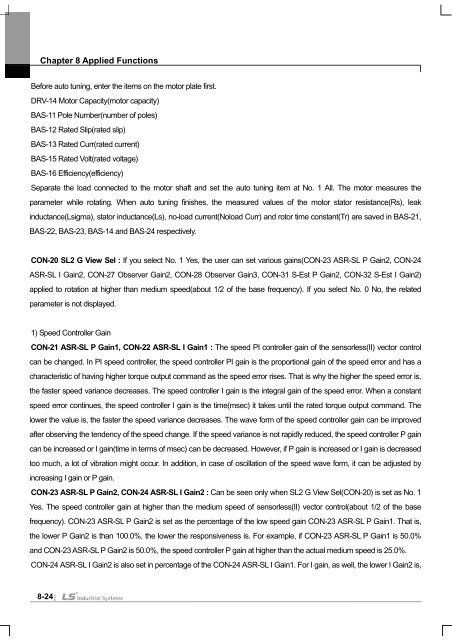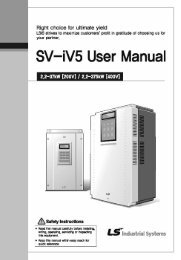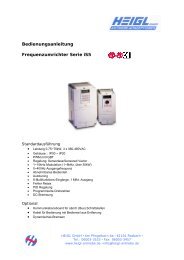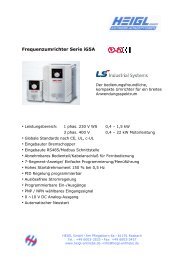SV-iS7 User Manual - Inverter Drive Supermarket
SV-iS7 User Manual - Inverter Drive Supermarket
SV-iS7 User Manual - Inverter Drive Supermarket
You also want an ePaper? Increase the reach of your titles
YUMPU automatically turns print PDFs into web optimized ePapers that Google loves.
Chapter 8 Applied Functions<br />
Before auto tuning, enter the items on the motor plate first.<br />
DRV-14 Motor Capacity(motor capacity)<br />
BAS-11 Pole Number(number of poles)<br />
BAS-12 Rated Slip(rated slip)<br />
BAS-13 Rated Curr(rated current)<br />
BAS-15 Rated Volt(rated voltage)<br />
BAS-16 Efficiency(efficiency)<br />
Separate the load connected to the motor shaft and set the auto tuning item at No. 1 All. The motor measures the<br />
parameter while rotating. When auto tuning finishes, the measured values of the motor stator resistance(Rs), leak<br />
inductance(Lsigma), stator inductance(Ls), no-load current(Noload Curr) and rotor time constant(Tr) are saved in BAS-21,<br />
BAS-22, BAS-23, BAS-14 and BAS-24 respectively.<br />
CON-20 SL2 G View Sel : If you select No. 1 Yes, the user can set various gains(CON-23 ASR-SL P Gain2, CON-24<br />
ASR-SL I Gain2, CON-27 Observer Gain2, CON-28 Observer Gain3, CON-31 S-Est P Gain2, CON-32 S-Est I Gain2)<br />
applied to rotation at higher than medium speed(about 1/2 of the base frequency). If you select No. 0 No, the related<br />
parameter is not displayed.<br />
1) Speed Controller Gain<br />
CON-21 ASR-SL P Gain1, CON-22 ASR-SL I Gain1 : The speed PI controller gain of the sensorless(II) vector control<br />
can be changed. In PI speed controller, the speed controller PI gain is the proportional gain of the speed error and has a<br />
characteristic of having higher torque output command as the speed error rises. That is why the higher the speed error is,<br />
the faster speed variance decreases. The speed controller I gain is the integral gain of the speed error. When a constant<br />
speed error continues, the speed controller I gain is the time(msec) it takes until the rated torque output command. The<br />
lower the value is, the faster the speed variance decreases. The wave form of the speed controller gain can be improved<br />
after observing the tendency of the speed change. If the speed variance is not rapidly reduced, the speed controller P gain<br />
can be increased or I gain(time in terms of msec) can be decreased. However, if P gain is increased or I gain is decreased<br />
too much, a lot of vibration might occur. In addition, in case of oscillation of the speed wave form, it can be adjusted by<br />
increasing I gain or P gain.<br />
CON-23 ASR-SL P Gain2, CON-24 ASR-SL I Gain2 : Can be seen only when SL2 G View Sel(CON-20) is set as No. 1<br />
Yes. The speed controller gain at higher than the medium speed of sensorless(II) vector control(about 1/2 of the base<br />
frequency). CON-23 ASR-SL P Gain2 is set as the percentage of the low speed gain CON-23 ASR-SL P Gain1. That is,<br />
the lower P Gain2 is than 100.0%, the lower the responsiveness is. For example, if CON-23 ASR-SL P Gain1 is 50.0%<br />
and CON-23 ASR-SL P Gain2 is 50.0%, the speed controller P gain at higher than the actual medium speed is 25.0%.<br />
CON-24 ASR-SL I Gain2 is also set in percentage of the CON-24 ASR-SL I Gain1. For I gain, as well, the lower I Gain2 is,<br />
8-24






